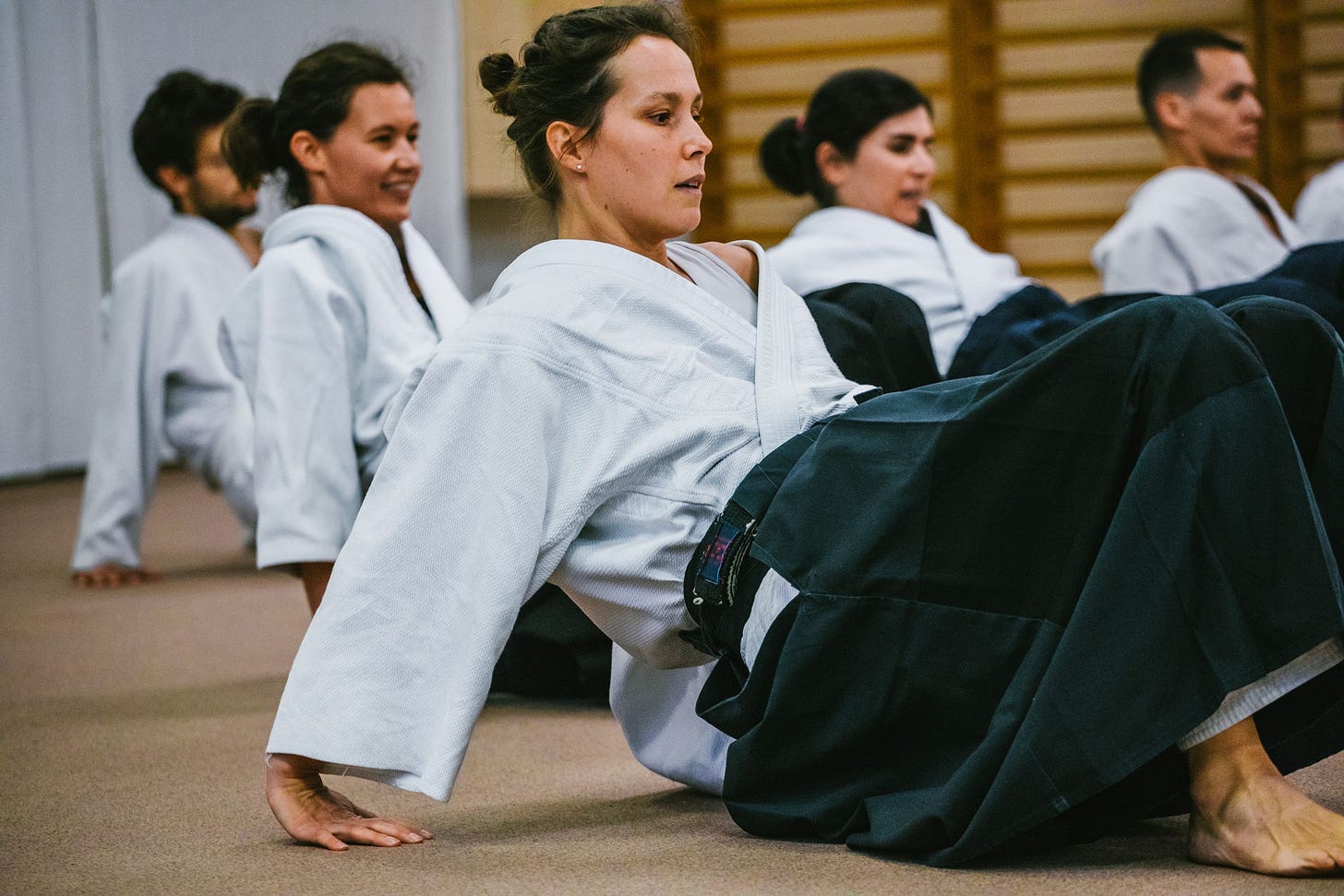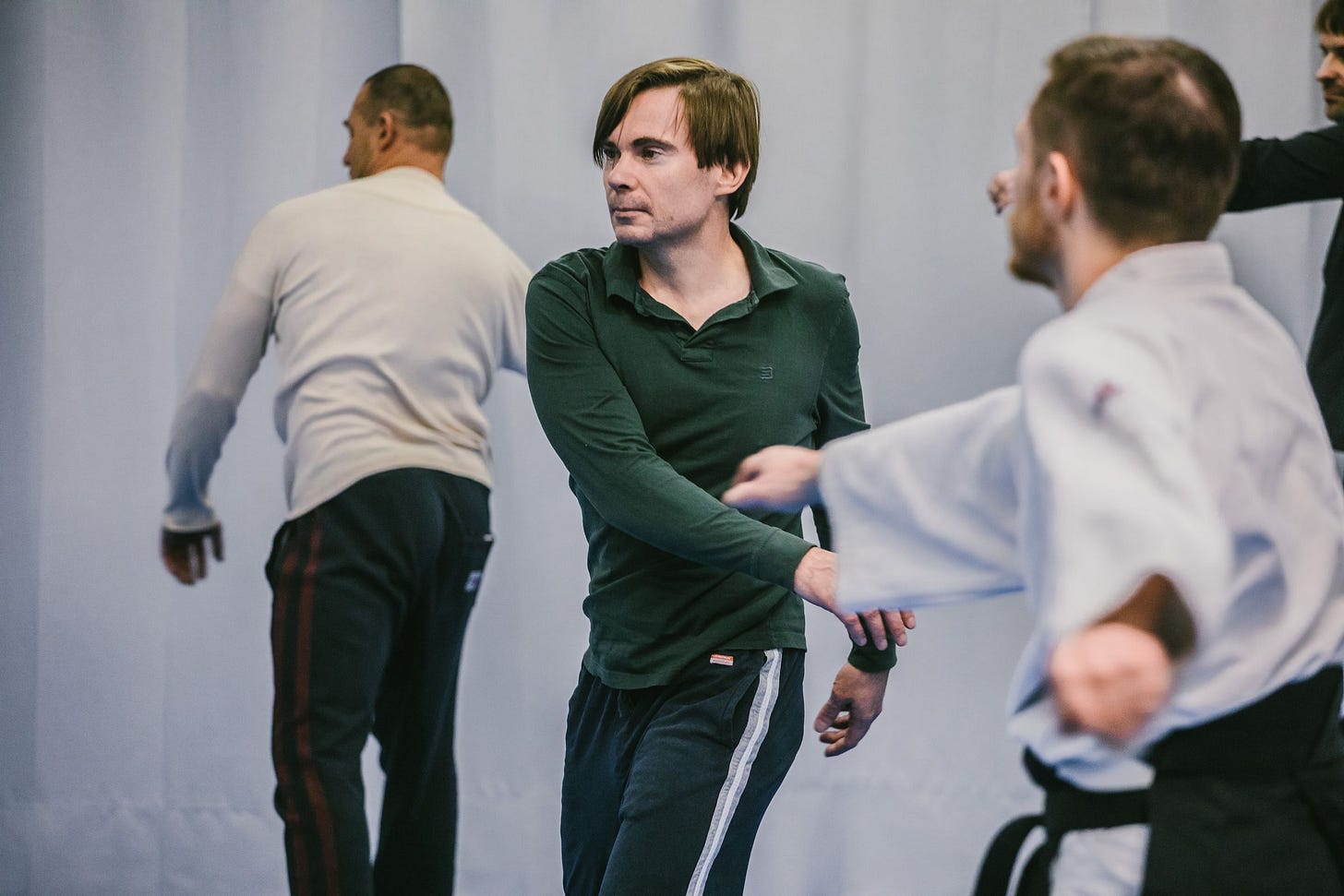(Lack of) Physical Literacy in Aikido Practice
Why Repeating Aikido Techniques Is No Longer Enough
Hello everybody,
this is an introduction to a series of texts about physical/motor development where I want to highlight the importance of teaching movement in Aikido.
Do you teach people how to move in your classes? Or do you just show irimitenkan and ushiro ukemi and you consider them ready to learn irimi nage?
Below I argue that in order to be able to enroll, develop and keep students in Aikido dojos, we also have to teach them how to move! Not only do we need it, it’s also fun!
Here are my reasons for focusing more on “physical education”:
People love to move and come to Aikido also for movement itself, so our practice should offer lively and joyful movement.
Even basic Aikido exercises such as turning and rolling often require some previous physical development, and we need to identify this and offer it to beginners.
To progress further in Aikido, we should also develop some physical abilities and skills as well as a body that is perceptive, conscious, and alive. Simply: our Aikido technique is better if the body moves better1.
To be able to stay in Aikido for a long time, we should use our bodies sustainably and naturally. Therefore we should study movement and do techniques and ukemi in such a way that develops us (not hurts us)2.
Aikido techniques, attacking, and taking ukemi… are fairly complex movements and require body and brain preparation to handle them. The “basic” motor skills3 should be developed before we dive into “specific” skills.
This basic movement competence can be called “physical literacy”4 and in professional sports, they know about the necessity to create these fundamentals before they go to the technique of the actual discipline.

We have nothing like that in Aikido and we need it more and more:
Traditionally we don’t develop physical literacy in Aikido: There is not enough basic movement education in our curriculum. While Aiki taiso, techniques and tori/uke work are interesting and versatile, they’re quite limited and don’t guarantee all-round body development.
People don’t come to us with physical literacy basics: As society changes, people move less and less in their lives and they have less physical education at school. So nowadays, Aikido beginners of all ages are less prepared even for the basic Aikido exercises.
In other words, people need basic physical development (physical literacy) when they come to a dojo and we don’t know how to teach it in Aikido.
The result is that beginners often fail our Aikido “requirements” and leave. As the Aikido community grows older, we’re moving even less in our dojos and then it’s even less attractive for beginners and young people - because they want to move.
A Short History of Physical Literacy Ignorance in Aikido
When Aikido was created, students had quite good movement skills when they entered a dojo. They were often advanced practitioners of other martial arts, or at least had quite solid basics, because judo and kendo were a part of the school curriculum in Japan. Moreover, people used to move much more than today in their daily lives. That’s why there was no procedure in Aikido to teach basic movements or even break falls - every newcomer could do that or learn quickly5.
Even in the nineteen nineties, when I started Aikido in Slovakia, most of us on tatami were former karateka and judoka, some came from other sports. I was lucky to be probably the last generation in our country who spent most of their childhood outside. We ran, crawled, climbed trees and rocks, threw stones or snowballs, and explored surrounding nature or urban structures (read roofs and sewers). Many of us even worked physically in gardens or fields with our parents. That’s how we developed our “physical literacy” naturally. There was no need to teach us how to move in Aikido, we knew it. And if someone came and couldn’t handle basics, we stated he or she had no talent.
Shortly: for the past 100 years of the development of Aikido, there was seemingly no need to teach people how to move in our classes.
Challenge of Today
It’s different today. Children don’t spend time outside. Some children move in some organized way for the first time when they come to Aikido at the age of 10. Most people just sit during their working days. It’s common to have 30-year-old beginners who come to Aikido after 15 years of not doing any physical activity6. Should we proclaim them all as not talented or suitable for Aikido?
The world has changed, it’s a situation we live in. No use blaming social networks, tablets, politicians, teachers at school, parents, or children.
We have indeed some more work to do. In order to be able to enroll, develop and keep students in Aikido dojos, we have to also teach how to move in Aikido classes!
I understand this can be quite a revolutionary statement for many. One teacher reacted: “We teach Aikido here! They should teach them how to move at school!”
Well, the reality in our country is that children at school haven´t been taught to move for 30 years. This means most people under 36 can’t move properly and don’t know their bodies. So how can we teach children and adults Aikido, when they can´t coordinate their limbs and they can hurt themselves even landing in a slow ikkyo omote?
So, do you crawl, jump, kick, throw, catch, push and pull in your Aikido classes, at least with children and teenagers? Do you develop body and brain abilities beyond the traditional model of uke/tori practice? Do you steal useful exercises from Taiji, Argentine tango, or the Feldenkrais method?
If you do, why and how? And if you don’t, how do you prepare your students for the complex Aikido movement?
Please share with us in the comments!
More articles about developing “physical literacy” and “cultivating the body” in Aikido are coming. Subscribe for free and you’ll get them into your mailbox soon.
The following text concerns improving movement quality for Aikido techniques, ukemi, and life: Crawling in Aikido? Seriously?
T.K.Chiba wanted his students to discover and cultivate their bodies (see for example his article Discovering the Body). I’ve heard a story that because he was not very specific about how to do it, some of his senior students went to study also other movement arts, often working with the Feldenkrais method - its slow and small movement beautifully contrasts with the dynamic of Chiba’s Aikido practice.
A person on Facebook once wrote me a comment that he did Aikido hard and it was all good, but then he destroyed his knees by practice and Aikido was over for him. I believe it can be done better.
By motor skills I mean eg. crawling, creeping, walking, running, jumping, throwing, catching, dodging, climbing… (https://mybrightwheel.com/blog/what-are-motor-skills)
Physical literacy is the ability to move with competence and confidence in a wide variety of physical activities in multiple environments that benefit the healthy development of the whole person (from https://en.wikipedia.org/wiki/Physical_literacy)
There are many testimonies for this, one is in this interview with Tamura sensei
This can vary in different countries and regions, I describe the situation in the Czech Republic. Count yourself lucky if your country has a better general physical education. However, in many “developed” countries the situation is even worse.
Related articles
Read more articles from cycle Movement Development in Aikido





Before being introduced to Physical Literacy and Dean Kriellaars by the Swedish Budo and Martial Arts Federation I had together with my friend Åsa Bergström in Stockholm invented our method "Happy Aikido" to inspire and motivate children and teens to train Aikido. We had published two books about it. When I realized our method was similar to the Physical Literacy wheel taught by Dean I became very happy. After many years now we know the balance between games, physical stuff, coordination, ukemi, props etc. And we get very good results with the AIkido as well, in fact, we realized that teens get even more motivated to learn "the real Aikido" when they do many different things. We have a Young Leaders training so that youths between 13-19 learn how to teach in a fun way according to physical literacy. If anyone is interested to know more or read/watch what we done, just reach out! Happy to share! And yes, to some extent this is also a natural part of the adult class when needed and the 65+ Senior training that we call SLOW Aikido. We are now a pilot dojo for senior 65+ initiated by the Swedish Budo and Martial Arts Federation to find a happy Physical Literacy training for that age group. Some people tend to think physical literacy and happiness is a threat to "the real learning" but our experience is the opposite. Better shape, better aikido, better ukemi. Best regards from Pia Moberg, Riai Aikido DOjo in Gothenburg, Sweden. www.riai.se
One of the greatest downfalls of "traditional" form is the reduction of movement complexity. Professional athletes understand this very well and continue to implement cross-training throughout their career. For Aikido, this is even more accentuated because the form does not include jumps, etc...so most of the movement performed in a Dojo is incredibly limited - exception being Kids' classes which often incorporate games and other ways to move (mostly to retain students, not for actual movement development). In our case, our movement programs combine somatic work with a very open movement exploration approach.
This is less popular with parents who want to see their kids line-up, receive color belts and trophies, and basically train highly impractical choreography. Ultimately, Dojo owners must walk a narrow path of student retention versus deep teaching. Sadly, society has determined that entertainment is king, therefore recreational classes have prevailed over deep developmental learning.
I do not know the state of affairs in other parts of the world, but in the US a huge majority of kids lack the most basic movement development pointing to the tragedy originating from diminishing physical free play outdoors with all of what it entails.